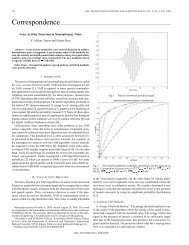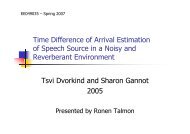Thesis (PDF) - Signal & Image Processing Lab
Thesis (PDF) - Signal & Image Processing Lab
Thesis (PDF) - Signal & Image Processing Lab
You also want an ePaper? Increase the reach of your titles
YUMPU automatically turns print PDFs into web optimized ePapers that Google loves.
26 CHAPTER 2. THEORETICAL BACKGROUND<br />
of the sequence s.<br />
For instance, {−1, +1, −1} � {−1, +1, −1, +1, +1}, and {} � {1, 1}.<br />
Proposition 7. The prefix relation � is a partial ordering, and (S, �) is a complete<br />
inf-semilattice, where the null sequence {} is the least element, and the infimum s ▽ r<br />
is given by the greatest common prefix, i.e.:<br />
where<br />
(s ▽ r)n = sn, n = 1, . . . , L(s, r), (2.11)<br />
L(s, r) = sup {n ∈ IN, n ≤ min [ℓ(s), ℓ(r)] | sn = rn} . (2.12)<br />
The proof is given in [17].<br />
In order to facilitate notation in the sequel, trailing zeros can be added to all<br />
binary sequences. I.e., let Z be the operator that maps each sequence into an infi-<br />
nite counterpart by appending an infinite number of zeros to it. The operator Z is<br />
invertible, and the inverse Z −1 consists of removing all zero elements of an appended<br />
sequence. Considering the set Z(S) of all 0-appended sequences, then it also forms a<br />
complete inf-semilattice with respect to the order given by the concatenation �◦Z −1 .<br />
In the remainder of the section, sequences are referred in this complete inf-semilattice<br />
only, and use � to denote the partial order of 0-appended sequences as well. More-<br />
over, the length of a 0-appended sequence will be by convention the length of its finite<br />
counterpart, i.e., ℓ(s) actually meaning ℓ (Z −1 s).<br />
2.4.3 <strong>Image</strong>s of Shape Sequences<br />
<strong>Image</strong>s of Shape Sequences are defined in [17] by Keshet.<br />
Definition 8. Let the image of shape sequences associated with an image f be the<br />
mapping sf : E ↦→ Z(S), such that sf(x) is the sequence of differences s(τ) for all<br />
shapes that contain τ(x), ordered from the largest to the smallest, followed by zeros.<br />
For instance, referring to the image in Fig. 2.4(a), and its modified tree in Fig. 2.5(b),<br />
for all x in region G, set sf(x) = {+1, +1, −1, −1, 0, . . .}, for all x in D and not in F,<br />
sf(x) = {+1, −1, 0, . . .}, and for all x in F, sf(x) = {+1, −1, +1, +1, 0, . . .}.
















